Best of Reaktor User library february 2.016
Effects
DRV-2000 Digital Reverb
by Guido Weber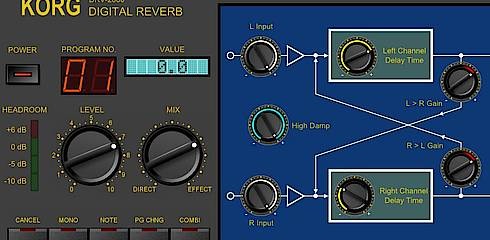
Multi purpose effect engine:
- Reverb
- Room
- Gated Reverb
- Stereo Echo (1 & 2 & 3)
- Flanger
- Chorus
- Space Panorama
- Reverb & Echo
- Reverb & Chorus
The physical KORG DRV-2000 is a 16bit digital reverb unit from the late 80's offering 16 read-only and 80 programmable presets.
The .ens eliminates the biggest disadvantage of the physical unit (complicated handling when accessing the parameters) by offering a GUI with immediate access to all controls. Add-on:
Possibility to run multiple effects in parallel or serial.
***
Knights of Ren
by Scot Bontrager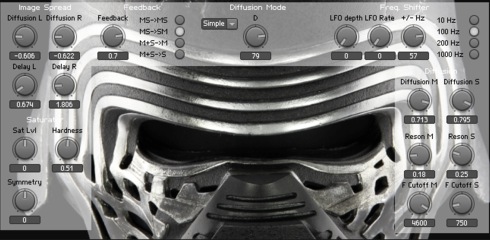
I was smitten by the sound of Kylo Ren's voice in the newest Star Wars movie. This started as an attempt to figure out what was happening to the sound. It just kept getting weirder and weirder.
0.4:
Saturator became multi-mode shaper: saturator, tube, wave fold and (the very nice) allpass array.
Small bug-fixes related to snapshot switching; if anyone knows how to make the saturator not pop on a snapshot switch, please let me know.
More presets.
0.3:
"Invert Bounce" diffusion mode. Quite fun.
Added a simple LFO to the Frequency shifter. This gives a vibrato effect, from subtle to extreme.
0.2:
Cheesy GUI
Multiple feedback modes
***
Sequencers
AutoDrummer
by Jim Hurley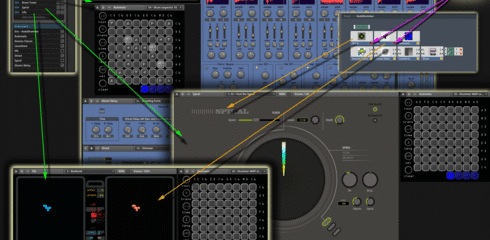
AutoDrummer is a self-generative Reaktor toy featuring 3 different MIDI automata: Automato, Spiral and Life. The image on the User Library page shows the different panelsets.
Automato by salamanderanagram (Donald Phillips) provides the MIDI notes for the rest of the ensemble; it can be used by itself, or programmed in turn by Spiral or Life which were both made by Lazyfish (Alexander Potekhin).
The sound generation section consists of an 8 part sample-based Drum machine - 'Gonzzo Classic' from the Reaktor 3 Library by Uwe G. Hoenig followed by a 'Stereo Delay' made by Thomas Medes, followed by the fabulous Laserbrew 1.3 by Tim Schwerdtfeger, followed by the granular Shred 1.0 by Christopher Lenz.
Any or all of the effects may be bypassed and there are many new snapshots for each.
I made modifications to all of these except Automato.
Included are 128 one-shot samples taken from my personal library (but for a few from the Reaktor 3 sample CD). From these I built 14 drum kits and you can easily make your own (with the help of a built-in Drum Tuner if you want pitched samples). A full GM drum assignment is in the sample map, but only 8 samples are used by Gonzzo. It is easy to extend Gonzzo by duplicating the internal samplers as many times as you like.
111 master snapshots are provided to show the variety of sounds that can be made. I don't consider this a drum machine at all, it is really a soundscape or texture generator. I didn't make any effort to provide 'traditional' drum sequences in this ensemble.
There are several panelsets that put the device in different configurations:
1) Automato alone,
2) Automato with effects,
3) the Drum tuner for adjusting Drum sample pitches (turn on in Gonzzo Classic B view),
4) Spiral driving Automato, and
5) Life driving Automato.
The Automato snapshots are oriented towards making drum patterns and note triggers for driving Gonzzo. The Gonzzo snapshots feature the 14 drum sets. The Delay snapshots are oriented towards percussive effects, Laserbrew provides some amazing resonances, reverbs, and distortions, and Shred provides a granular sound quality if that is your poison.
Gonzzo was made fully stereo and uses MicroSpace for its reverb instead of the original reverb design. The B view shows the Drum Tuner - when turned ON it generates a fixed pitch when any note is played.
I added a saturator to Stereo Delay and a few other minor tweaks.
Laserbrew has had a new layout along with the GUI, but the sound has not been changed - I just wanted to study its internal design better. The A view has a bunch of displays added to help make snapshots - the B view is a little simpler. I did add a limiter by James Walker-Hall which is OFF by default. This can help tame wild resonances.
Shred has a number of changes, look at the Info notes to see them.
The two MIDI generators - Spiral and life - are initially muted so that they don't start generating anything (and they use a lot of CPU when ON). They may be displayed in two panelsets, but they won't do anything until you open the structure and UNMUTE the macros that you want to use (one at a time). You can also unmute from the instrument properties.
All the instrument snapshots are managed by the Master snaphot bank, so make sure you are looking at the correct bank when you select a sound - its easy to get lost in the banks.
The first few snapshots introduce the drum sounds, but gradually the snapshots get more adventuresome.
There are separate sections for the drums and effects and for the Spiral and Life patterns.
Spiral is essentially unchanged except that I exposed an inner All Notes Off button if you need it, and a way to turn off MIDI events.
Life was taken from Newscool and seriously bent. I took parts from Spiral and made it do things that no one should be made to read about - truly unspeakable tortures.
These two automatons generate the MIDI notes from 36 to 99 that are used by Automato to start a node in one of the 64 cells.
Since Life can generate up to 1024 MIDI events, it will easily swamp out the CPU if you do the right things. That's why it is turned off.
You can run Spiral and Life together to drive Automato but my CPU is not fast enough to do that. You could break the ensembles apart and place them in a DAW so that they run in separate cores - that exercise is left to the user. The MIDI outs of Spiral and Life are sent internally to Automato.
I wish I could take more credit for this, but most of it was all made by other people - the talented pool of creative Reaktor builders.
***
Drummage
by david els on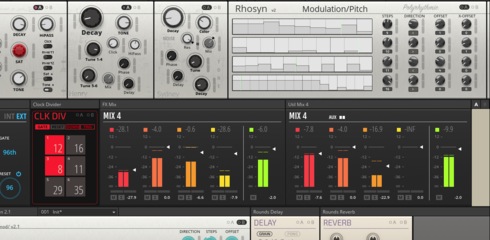
Drummage: Two sequencers, three drum blocks, some fx and a few presets....
***
Get To The Chopper
by Nik Kaloper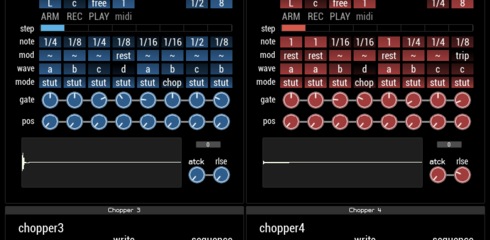
Record samples into the audio tables to chop and stutter them with the sequenced parameters.
I've included lots of hover text in to main area and on Chopper 1 - so to get detailed instructions on its use, make sure the info button is selected in the top of Reaktor.
I've made this specifically with the intention of learning more about Reaktor - I'm sure there are a lot of areas for improvement, I plan on addressing them in future revisions or altogether new instruments.
As always, any and all feedback is welcomed
the .zip files includes
GetToTheChopperINST.ens - instrument with some embedded samples
GetToTheChopperINST_empty.ens - instrument with initialised patch and no samples
GetToTheChopperINST_6Out.ens - each chopper has its own audio output (1-4) and FX on stereo output (5&6). In your daw you can route each chopper to its own track and have more control with automation and applying your own FX.
***
rachToy XY v3
by rick scott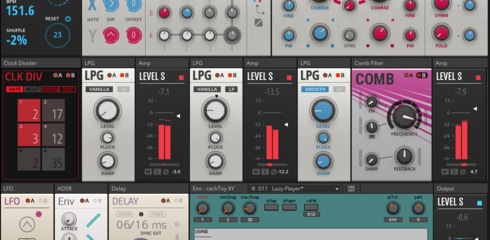
Makes quirky noise-rich patterns from a mod of NI's XY.
Follow usage instructions for plink-plonk optimization.
Note: It uses the INT clock, which you might need to stop/restart.
Enjoy!
-----------------
v3: Added dynamic panning.
v2: Improved randomization. Added some custom snapshots.
***
Riddum / Jitterdrums
by Lawrence Vriend
This ensemble can create complex poly-rhythmical percussive loops. It consists of two instruments that can also be used separately:
RIDDUM
Riddum is a sequencer which is designed for the easy creation of complex and idiosyncratic rhythmical patterns. Ordinarily, the clock that drives a sequencer pulses in a regular and constant tempo. This instrument allows for precise control over the clock tempo. It consists of two parts which need to be programmed in conjunction: the POLYRHYTHMIC CLOCK that creates the rhythmic pulses by subdividing segments of a measure into up to 96 pulses, and a gated SEQUENCER with many editing options.
JITTERDRUMS
Jitterdrums is a relatively straightforward sample-based drum machine that features an interesting controller. You can set the controller to a specific value or you can define a range for it. The controller will output the set value or a random value within the defined range every time it gets triggered. This helps create a wide range of percussive sounds that sound organic and varied. The sampler features FM-modulation and the samples can be degraded and run through an overdrive effect to generate harsh and aggressive percussion.
Both instruments were designed to be user-friendly. Please read the hints/info for more information on how the different control elements function. Listen to the ensemble snapshots to get an impression of what these instruments together can do.
***
Samplers
eXistenZ II
by Dieter Zobel
Modificated version of TravelLisa,
a SickleBoz collaboration anno 2007.
Thanks to Mr. Donovan Stringer for dark Influences. Much time is passed since then. But no matter, its still a nice toy.
Revised by didier leboz 2015.
Haben Sie bitte Spass.
sample import correctly now
***
GRAINDRAIN
by jason pottorff
Updated for Reaktor 6.
All thanks to Peter Dines and his Very Simple Grainer. And the many others that made the little parts, too. Chime in if you recognize your pieces.
A drone maker, for sure. I hope you can find a home for this (or please take it to the next level and share!), even though I suspect many other ensembles do the same thing as this, only better. :)
***
g(rand)Master v3
by rick scott
What do you do with a brilliant Colugo block? Build a randomization scaffolding around it of course! Usage instructions hard to miss. ;-) I like to think of this as a worthy successor to the great und mysterious White Grains.
Enjoy!
--------------
v3: Added min/max frequency ranges to vLFOs.
v2: Uses v1.3 of Granmaster, allows for audio in.
***
Jazzyspoon MADNESS
by jason pottorff
Updated 1/22/2016 for Reaktor 6.
Another Frankenstein from deep in the laboratory. All the parts made from other parts that were possibly taken from other parts of brilliant works by various members of this NI community. i take no credit for anything in this except for some light construction/design and a need to fulfill.
Mostly, just load the 2 samplers and tweak away. I added a small mixer on the right for live purposes. I have gotten some decent sounds out of this. Loaded a few samples, but it begs for some new sounds.
Enjoy and many thanks to you all. If these are insulting to the original designers (Zobel?), please voice up and I'll stop posting them. (I will totally understand)
All parties I could trace back to are thanked in the ens., but also thanks to the button designers out there. half of what i enjoy in putting these together is all the wonderful buttons, levers, and gizmos to add to interfaces. I project my screen on the wall behind me when I play live so people know what the hell I'm doing and I love having some flashy looking stuff (more so in my other uploads) to show off.
***
RUIDOZ v1.1
by Sylvain Stoppani
Ruidoz is a sample based virtual machine for making beats or soundscapes.
This audio mangler consist on 127 shorts electric, liquid and metallic samples, played in a random mode or in single mode.
All are processed by 4 lines of effects ( multi, filter, looper and reverb) and launched with a step sequencer.
Ruidoz aimed to be played live or for producing strange rythmic patterns.
Changelog 1.1:
- new stereo pan : I found it misses when you want to externally control the stereo image.
- in/out button to enable external midi output : disable the sequencer and launch Ruidoz samples with your keyboards, midi pads or any midi gate input. ( note : the pitch is fixed on the same root note for every keys)
- more precise ADSR enveloppe
- now the Looper is independant from the FX level section,
- I cleaned up the ensemble and morph/isolate some parameters, so now, it's working better with the snapshots randomize/morphing functions.
- some additional hints & presets.
***
SONGFREEZER
by jason pottorff
updated for Reaktor 6.
This is another CPU eating beast from my live collection. Nice for making some glitchy grainy ambience. Load your own samples and away you go! (though I have left a lot of the original L3 and grainstates sounds intact for this library version)
Thanks go to everyone who made all the parts Zobel, Lazyfish, rachmiel, James Walker-Hall, Martin brinkman, etc. - the usual suspects.
Peace and I hope you can at least have fun playing around with this.
Use the play button on this to stop the drums and freeze (sort of) the drone pad...
***
Synthesizers
Fluffy
by Paul Woodroffe
Fluffy is a wholly unremarkable poly synth, with two oscillators. It was designed from the outset with the idea of making big pad sounds. It can do that quite well, but can also make some very fat bass sounds too.
I have stored output level with the snapshots but I've always been unsure about whether that is a good idea or not - so I apologise in advance for patches being too loud / quiet / distorted.
The patches are mostly "musical". I'm a grumpy old git, so I don't usually bother with "FX" patches - so you can make your own discordant Klanky Soundz™, if you so desire.......
1.01 Update: Changed to show snapshots in main title bar!
***
Juno.60 2.11
by Guido Weber
Version 2.1
Synthesizer built after the Roland Juno-60, containing all 128 factory presets. Included are two GUI versions (the small one is limited to 1024x786 pixels).
View B contains the backside controls and some additional features not included in the physical JUNO-60:
Chorus dry/wet, low shelf EQ, keyboard velocity on/off, key click, DCO pitch spreading.
Version 2.1: Fixed some bugs in the Arpeggio section, the rest of the ensemble is untouched.
Known problem: In certain conditions the ARP produces wrong notes if keyboard is played legato and HOLD is turned off.
***
